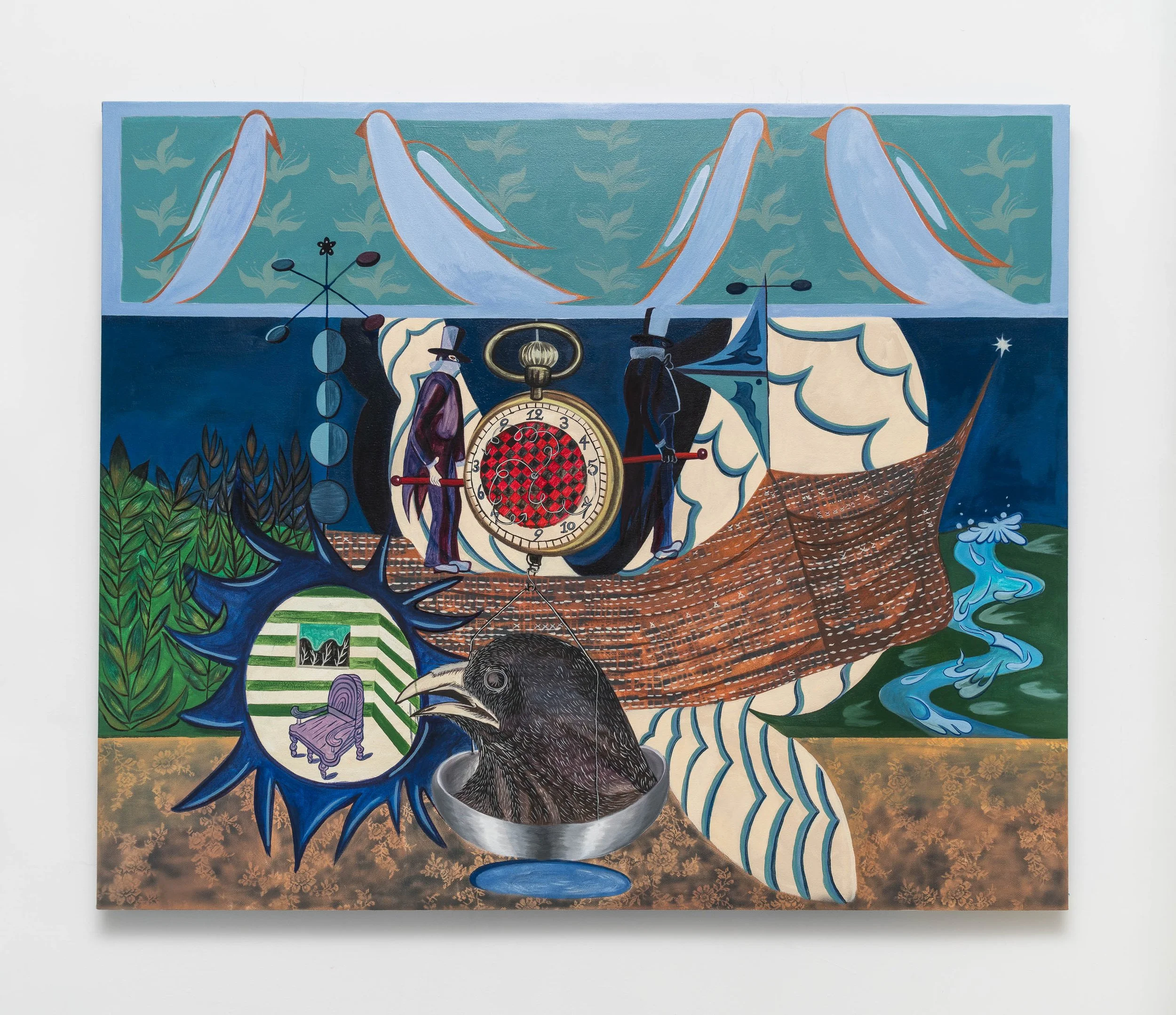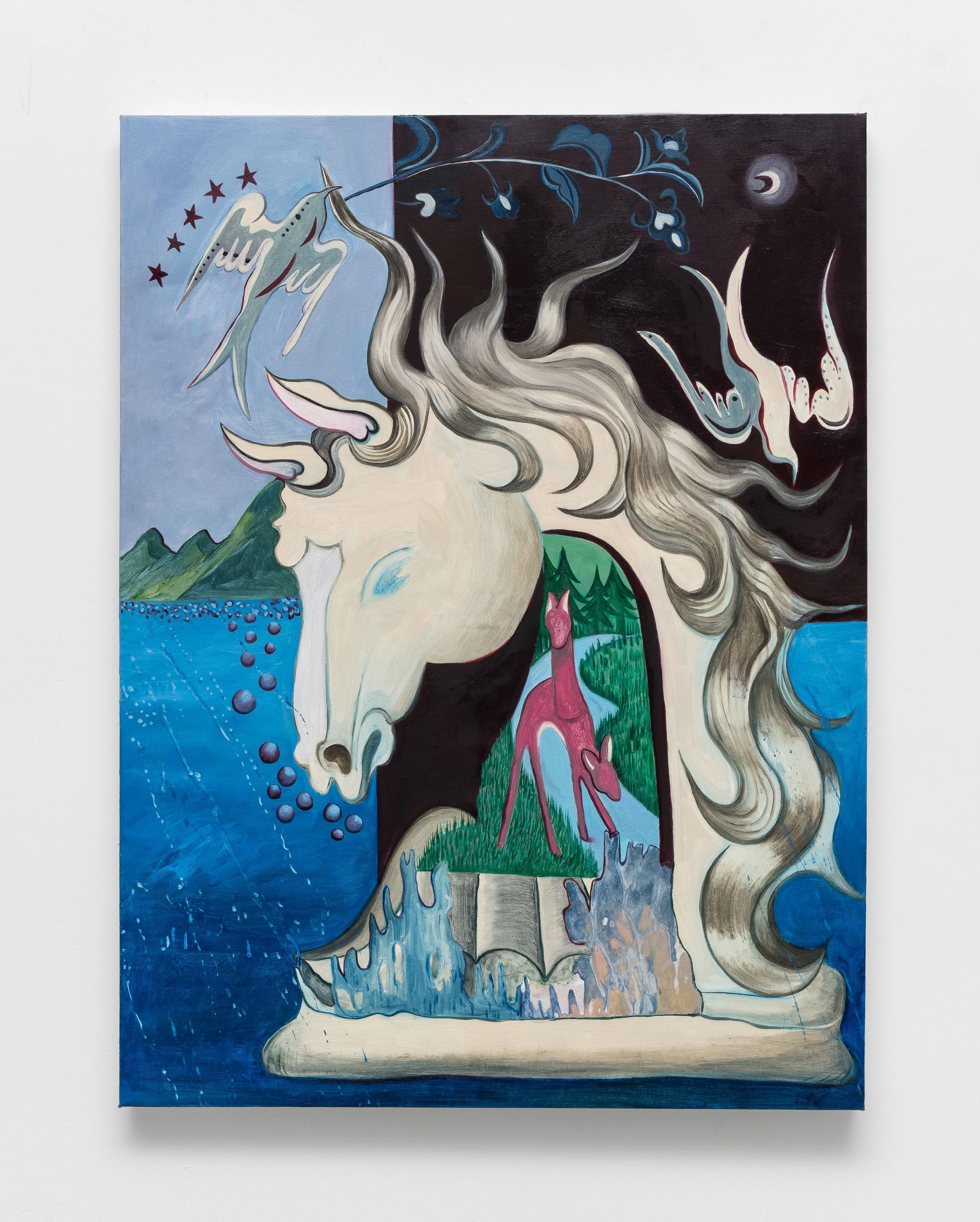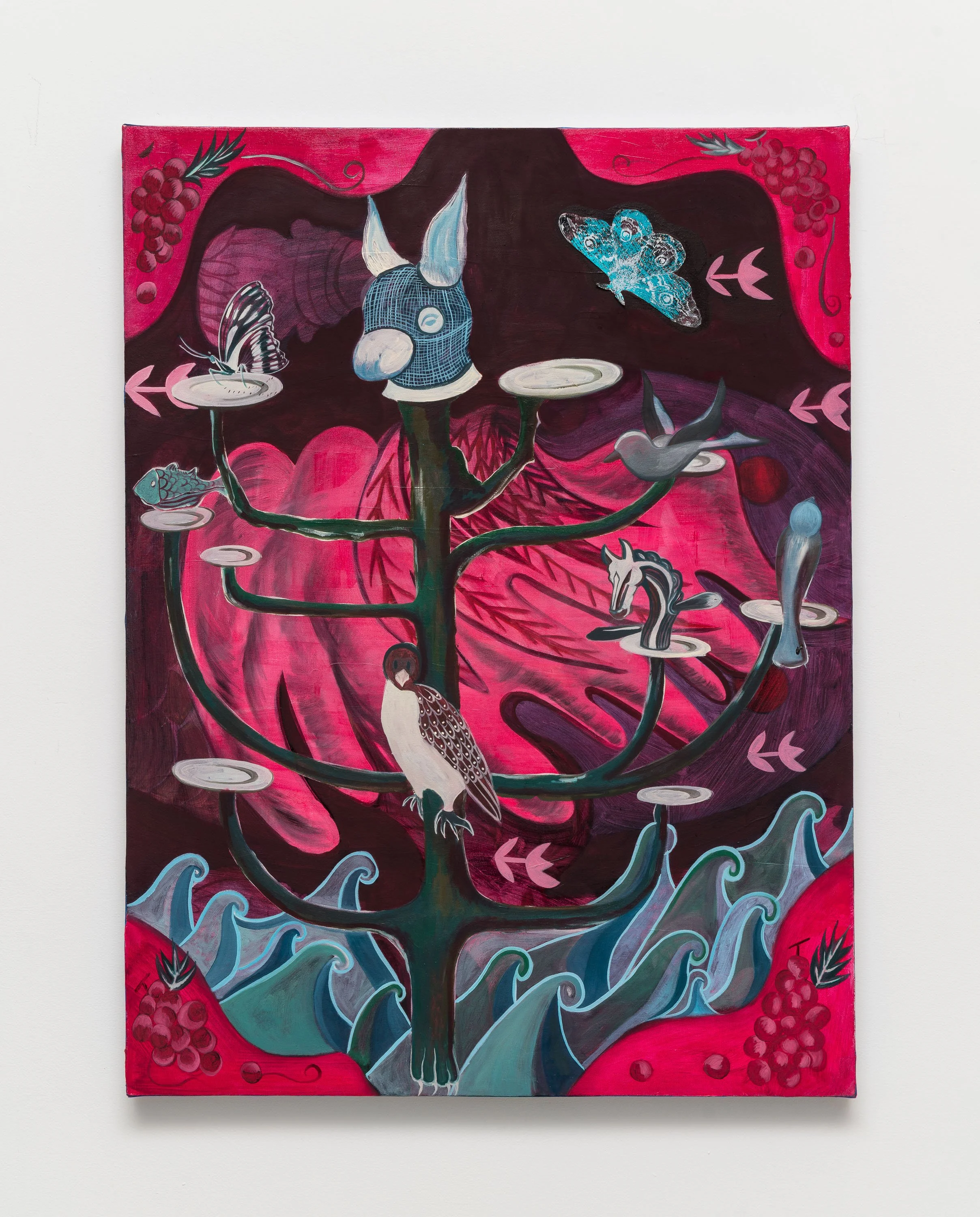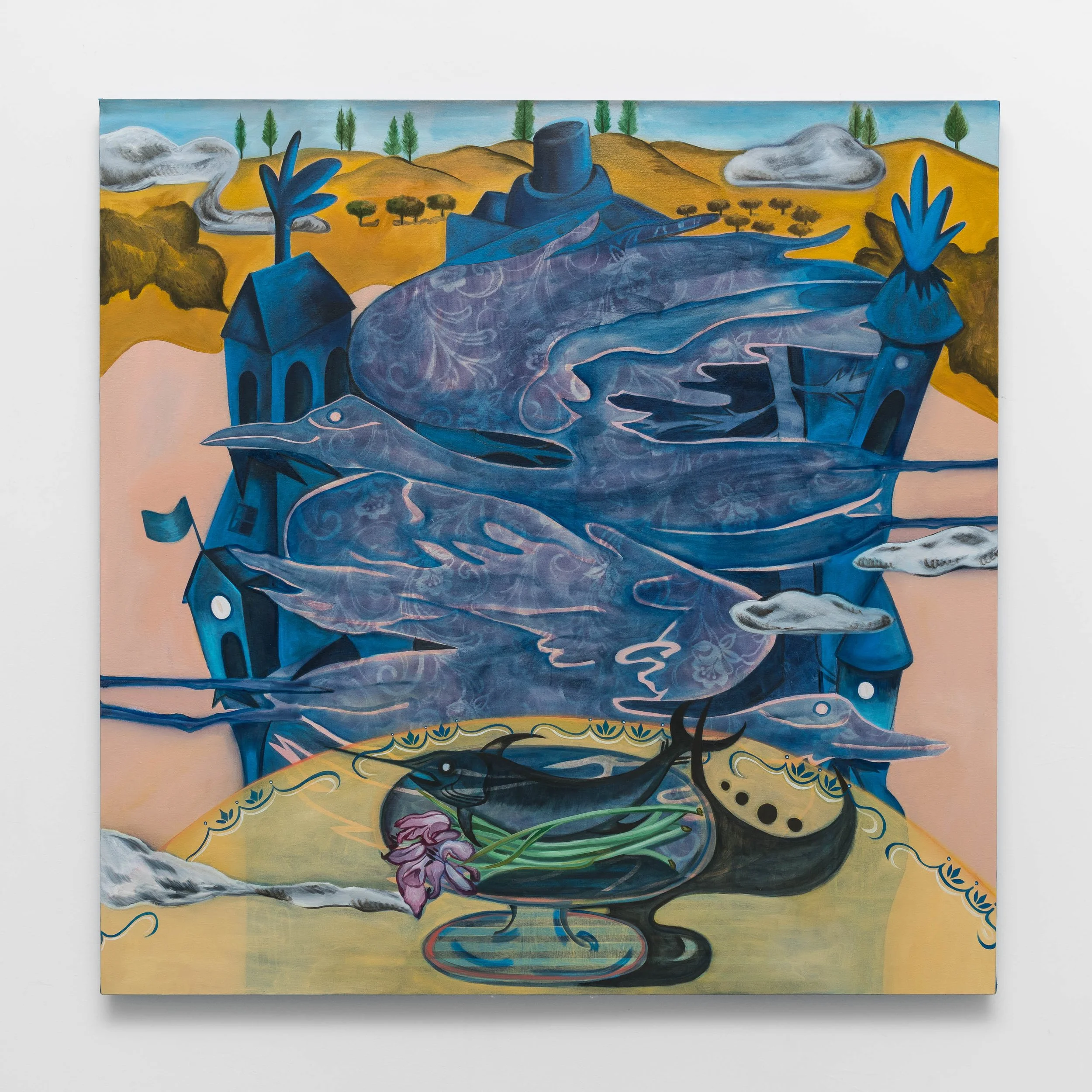Jingqi Steinhiser

Could you tell us a bit about yourself and your background?
I'm a multimedia painter born in China and raised in Mongolia. I received my MFA in painting at Rhode Island School of Design (RISD) and BFA in painting at School of the Art Institute of Chicago (SAIC).
I grew up in a family of diplomats, a learning journey that mutated across geographies. Born in China, I lived a nomadic life in Russia, Mongolia and South Korea before coming to the USA. I've never stayed anywhere more than six years. My current work looks at animal patterning, gaming designs and power structure behind pop cultural symbols and scenarios in late capitalism. My paintings are uncanny and survey the denial of narration and the interruption of the audience’s act of reading through an interwoven relationship of surface environment and humor.
Your paintings are filled with hybrid animal forms and fantastical spaces. How do these imagined creatures reflect your exploration of identity and displacement?
I’m creating these imaginary surreal spaces for myself and people with similar experiences to exist in. Over time, as I adapted to various cultures and environments, I began to understand displacement—not just as a geographical experience, but as an emotional and existential condition. The sense of fragmentation and alienation I felt became central to my work. The creatures I create are responses to that: they are imagined hybrids, formed from multiple cultural references, mythologies, and personal memories. They carry layered meanings—like the snake, which is seen as sinful in Western traditions but symbolizes fertility and renewal in many Asian cultures, or the phoenix, a symbol of rebirth and resilience.
In my practice, these creatures become vessels through which I process the complexities of identity. They inhabit fantastical, surreal spaces that are neither here nor there—neutral worlds that reflect the fluidity of belonging. These environments offer a sense of refuge, mirroring my desire to create spaces where those who have experienced cultural dislocation might find recognition, resonance, and connection. Through these beings, I am continuously building a visual language that speaks to the in-between: between places, identities, and emotional states.
You reference Mongolian Shamanism and animism in your work. How do these influences shape your understanding of animals as both personal symbols and cultural allegories?
Growing up as a nomad in Mongolia, animals were central to daily life—not only as sources of sustenance and transportation, but also as companions on long journeys through vast landscapes. Movement and migration were foundational to my upbringing, and through that constant motion, I came to understand that there is never a fixed destination—only an ongoing search for betterment and sanctuary. However, that journey also brought with it a sense of displacement, a fragmentation that exposed me early on to the feeling of alienation. In that experience, animals remained a constant presence—both as real beings and as spiritual companions.
Informed by Mongolian Shamanism and animism, I see animals not only as symbols rooted in personal memory but also as cultural carriers of collective meaning. Many animals appear in my work not just for their physical form, but for the layered symbolism they carry across cultures. For instance, snakes represent sin and temptation in the Western biblical tradition, yet in many Asian cultures, they are revered for their association with fertility and renewal. Similarly, mythical creatures like dragons and phoenixes—though they do not physically exist—carry profound cultural weight, often linked to imperial power, rebirth, and resilience.
These beings populate my paintings as narrative agents, bridging the personal and the mythological. They allow me to explore themes of identity, transformation, and the tension between cultural specificity and universality. In this way, animals become both anchors of memory and vessels for storytelling—deeply rooted in the knowledge systems I grew up with, yet continuously evolving within my visual language.
Having lived across Russia, Mongolia, Korea, and the US, how has your nomadic upbringing influenced the evolution of your work and the way you approach painting today?
I didn’t fully grasp how deeply my nomadic upbringing had influenced my work until graduate school. Early on, my practice centered around documenting scenes and moments that I had experienced but couldn't fully process—there was a constant undercurrent of searching for a place to belong. Over time, I’ve shifted from viewing this transience as displacement to embracing it as a generative framework. My work now reflects a dual awareness: on one side, a deep curiosity and appreciation for the visual languages I’ve encountered—cultural patterns, symbolic systems, and alternative modes of thinking—all of which I integrate into my paintings. On the other side, the psychological impact of rapid adaptation manifests as a sense of ambiguity and measured momentum throughout my compositions.
Today, I see my paintings as constructed, surreal environments—neutral yet emotionally charged spaces where those navigating cultural hybridity or identity displacement might find resonance. In a globalized world where belonging is increasingly complex, I aim to create visual worlds that offer connection, contemplation, and a sense of shared interiority.
Tell us a bit about how you spend your day / studio routine? What is your studio like?
I work best with a clear boundary between home and studio, so having an external space—ideally within an artist community—is essential to my practice. My studio routine often begins with writing—simple reflections on thoughts or experiences that have been occupying my mind. For instance, after recently returning to a humid climate following years in dry environments, I wrote about how humidity feels like a passive form of depression—inescapable, ever-present, and clinging to everything you touch. These writings help give me the emotional entry point for creating the surreal spaces in my work.
Following this, I typically review recent pieces to assess how they relate to one another and whether they spark the next direction in my practice. This reflective process helps create continuity while allowing room for experimentation. That said, not every day follows this structure—there are times when I feel the need to bypass routine altogether and dive directly into painting. I try to remain responsive to what the work demands each day, allowing intuition to guide the process.
What artwork have you seen recently that has resonated with you?
One exhibition that has deeply resonated with me recently is The Beyond – Hilma af Klint at the National Museum of Modern Art in Tokyo. I’ve long been fascinated by af Klint’s visionary use of color and composition, but seeing her work in person brought a whole new level of appreciation. Her ability to synthesize knowledge from diverse disciplines—particularly orthodox religious iconography and botany—into a language of geometric abstraction is profoundly moving. What strikes me most is how she created imagined spaces that transcend time, grounded in a meticulous yet intuitive sense of order.
There’s a quiet rigor in how she systematizes the spiritual and natural world into abstract forms, and that resonates with my own artistic practice. My work is an exploration of creating a spiritual, surreal world through my own knowledge of language and cultural patterns. Her work feels both deeply personal and universally expansive, a rare combination that invites viewers to contemplate the unseen forces that shape our reality. The exhibition left me reflecting on how structure and spirituality can coexist, and how abstraction can be a powerful means of personal and cultural expression. It was a timely and inspiring experience that continues to influence how I approach my current projects.
Is there anything new and exciting in the pipeline you would like to tell us about?
Absolutely! I'm currently in Itoshima, Japan, participating in an art residency and will be based in Japan for the next two years as I conduct research exploring the intersection of cultural patterns and migration. Later this year, I’ll also be heading to France for another residency, and I’m looking forward to the insights and inspiration that experience will bring. In addition to residencies, I’m preparing for several exciting exhibitions: in May 2026, I’ll be presenting my first museum solo show at the Chinese American Museum of Chicago, followed by a duo exhibition at Heaven Gallery in June. On the other side of the world, I’m thrilled to share that I’ll be having a solo exhibition at the newly established Feng Zikai Art Center in Asia (date to be announced). It’s a dynamic and inspiring time, and I’m excited to see how these experiences continue to shape my practice.



